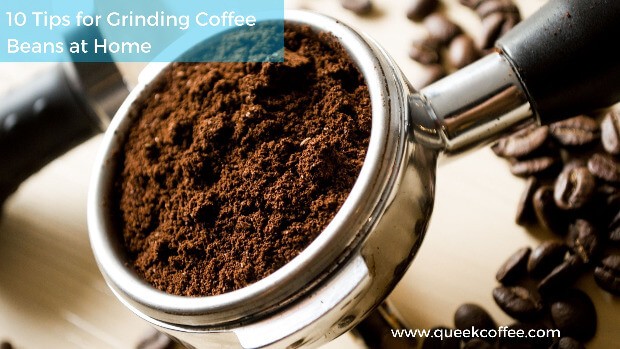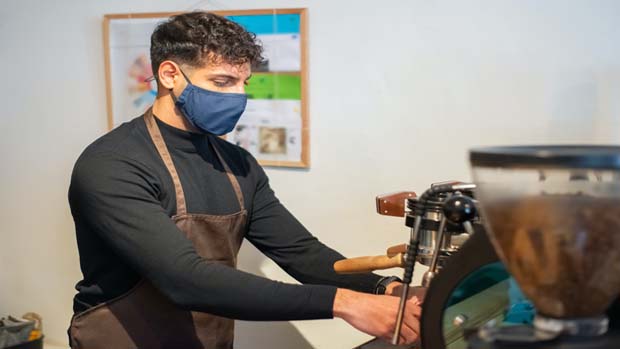How to Grind Coffee Beans at Home. There are many ways to grind coffee beans at home, but most require special equipment and/or extensive time commitment and attention to detail to get the job done right.
In this article, I’ll show you the ten tips and tricks I’ve picked up over the years for grinding coffee beans at home more efficiently and quickly than you ever thought possible!
1. Buy a coffee grinder
If you want to grind your coffee beans at home, purchasing a burr grinder is essential. Blade grinders chop up beans unevenly, affecting both taste and aroma.
They also produce heat when grinding, altering a bean’s natural oils and roast characteristics. Avoid buying coffee mills and those pod-based coffee machines:
Both are designed with ease of use in mind (the food processor-like setup means you don’t have to be precise about how much coffee or water you use), but they produce bad-tasting coffee and are cumbersome to clean (pod-based models, in particular, suffer from clogging).
For great flavor and freshness every time, invest in a burr grinder.
2. Freshness is key
One of your main goals when grinding coffee beans at home is to preserve as much flavor and aroma as possible.
Luckily, there are a few ways to do just that. For one, grind your beans right before you brew your coffee. Since heat is bad for aromatics, keep ground coffee in an airtight container (like a mason jar) in a cool place.
That being said, grinding cold beans also helps keep them fresh so store some whole and save them from grinding over time! If you prefer to buy pre-ground coffee, look for roasts no more than seven days old!
Lastly, make sure that you and your grinder are clean and oiled (with machine oil or citrus oil) regularly. It’ll help ensure a smooth extraction every time!
3. Don’t go overboard on the grind
Grind your coffee beans just before brewing. If you store ground coffee, it loses flavor. Freshly grinding your beans, or getting them pre-ground from a local roaster, will help ensure that you’re making a fresh cup of java every time.
There’s nothing worse than taking your time and energy to make a fantastic cup of coffee only to discover it tastes stale because you bought your beans on sale a few weeks ago and stored them improperly.
4. Give your ground coffee time to breathe
When you grind coffee beans at home, it’s essential to let them breathe for about 20 minutes before brewing them. This allows for a more intense aroma, making your final product flavorful.
In short, enabling coffee beans to breathe helps them release their flavor into your cup. Ground coffee is typically only exposed to oxygen while being bagged—when it hits our countertops and brewing devices, there’s very little room left to expand or breathe.
Give ground coffee a few minutes, and it will taste noticeably fresher and more flavorful than before grinding; give whole-bean coffee an hour, and you may find yourself drinking extra cups just because of how good they smell!
5. Start with pre-ground beans when you need them now
If you need your coffee right away, there’s nothing wrong with using pre-ground beans—it’s sometimes unavoidable.
But grinding your own is best if you have time. If you use pre-ground beans, pay attention to how long they have been since they were ground; sometimes, coffee starts to go stale two weeks after ground.
The higher quality your coffee beans are and the more freshly roasted, the better chance you have of enjoying them at their peak flavor.
And most importantly: make sure that whatever grinder you use is clean! You want those delicious flavors to go into your cup of joe and not onto your countertop.
6. Store in an airtight container
After grinding coffee beans, store them in an airtight container to help keep out oxygen and humidity. Oxygen can degrade your coffee beans over time, so storing them appropriately will help keep them fresh.
If you need to make a large amount of coffee at once or are storing your beans longer than two weeks, consider purchasing a vacuum sealer to remove as much air from your storage container as possible.
Ideally, coffee beans should be stored in an airtight container in a cool, dark place. Storing them too close to something like a refrigerator or freezer can compromise their flavor.
If you don’t have space for a proper coffee bean storage container, you can use any other kind of sealable jar or bag. Just be sure to keep your beans away from light and moisture when storing them.
7. Use extra care when grinding multiple types of beans at once
If you’re grinding multiple types of beans, it’s essential to take extra care not to over-grind. Each variety of beans absorbs moisture at a different rate and grinds differently.
You want your grinder to sense how much pressure it should exert based on what kind of bean is in there; if you try to force too much pressure into one grinder setting, your coffee may end up either under-or over-ground as a result.
Different brands of burr grinders will handle multi-bean environments slightly differently, so do some research beforehand and find out what works best with your equipment! [1] Also, electric burr grinders tend to perform better with multiple types of beans than manual grinders.
8. Choose a grinder based on what you grind most often
Whether you’re new to coffee or a seasoned professional, everyone has different opinions on grinding coffee beans.
When it comes to grinding coffee beans, there are two basic rules of thumb:
- Whatever brewing method you choose, use a grinder that is appropriate for that technique; and
- purchase whole beans rather than pre-ground—the best way to get started is with a hand grinder.
Grinders come in all shapes and sizes—from inexpensive models to commercial machines. Experiment with several until you find one that works well for your brewing techniques.
Look at how many ounces it can grind per minute and any accessories it might have—for example, burrs or blades will produce different particle sizes.
9. Match your grinder with your brew method
You don’t need a specialty machine to grind coffee beans at home. The biggest mistake people make is grinding their beans too finely—it might look nice, but it results in a gritty cup of coffee.
You want your ground coffee to resemble coarse-grain sand, not talcum powder. The best grinders are burr grinders because they offer more control over how fine or coarse you choose.
Burr grinders have two sharp blades that move back and forth against each other, pulverizing your beans into whatever size you desire (the lower blade spins clockwise, and the upper blade spins counterclockwise).
Our favorite is Baratza Encore because it’s small enough to throw in a kitchen drawer but still does a fantastic job.
10. Keep detailed notes on how you use your grinder so you can adjust settings
Four main variables determine how fine or coarse your coffee grounds will be:
- Grind setting
- Brew method
- Amount of coffee used, and
- The fineness of the grind setting
Use a quick note system to keep track of each variable so you can adjust for next time. For example, if you found that a fine grind worked best in your french press, but a coarse grind created good results in your drip coffee maker, you’ll want to use notes when making adjustments.
Some people recommend writing a number or letter on small pieces of tape and placing them on each section where a variable is adjusted so you can quickly compare your findings later.
The first thing to remember is that coffee beans quickly lose their freshness and aroma. If you’re not going to be grinding it immediately, it’s best to buy whole beans from a trusted source—never pre-ground coffee—and grind only what you need.
We also recommend storing your freshly ground coffee in an airtight container in a cool, dark place and using it within two weeks. Here are some other tips: Read your owner’s manual before using your grinder; although most burr grinders are straightforward, they all have slightly different instructions.
If you don’t follow them precisely, you could damage your equipment or create uneven grounds, making bitter-tasting coffee that nobody wants!

Zakir Hossain is the accountant of Dan Foods Limited (Dan Cake BD). He loves his family, and whenever he gets an opportunity to spend leisure time, he utilizes it by brewing coffee and enjoying it with his family. He has a beautiful baby girl name Sara Zakir.





